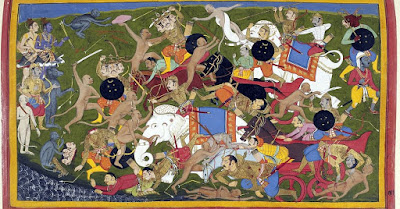May I Come In Madam?- A Study on Stereotypes, Male Gaze and Female Objectification
Tarak Mehta Ka Ooltah Chashma' started a genre of brainless comedy and ' May I come In Madam?' falls under this category. Given the deluge of TV shows on OTT platforms, one doesn't come across such shows if not listed in Top 10. With the peer pressure gravitating towards Squid Game, why would you fall for it? Your time is precious, isn't?
I came across this montage through a dear one. Finding it amusing to hear the laugh and giggle travelling to the adjacent room where I was lying down reading a book, I decided to have a look.
I sat in the sofa and started watching in medias re.
Ten minutes into the show, my high brow inner-self started judging me for even adding another minute to it. “ You! The pupil of high masters like Aristotle and Horace, who has gone through the the works of Marlowe and Eliot is stooping to the absurd!” Throughout the watch, I was befuddled. The laugh and snort came out of sheer bemusement and derision. In reality, I was too spoilt for the ‘ordinary’ amusement.
Conceding to the voices inside, I decided to leave. As I stoop up, the dear one gave a questioning look but was too engrossed in the show to further enquire.
Back in my room, with the ridiculous scenes in the show replaying in my head, I got reminded of the slapstick, farcical comedy shows and also Aristotelian interpretation of Comedy in Poetics.
As I was pondering on the other dimensions of the comedy, I heard Kashmeera’s mother heaping accusations against her son- in - law of alleged affair while singing like a lark and also mimicking a few Bharatnatyam steps.
‘I can’t think while the show is still running.’ I said in a huff.
Again I hear, ‘Aaaaahaaaaa Aaaaahaaaa ……’ sleazy background song accompanying Sajan’s fantastical encounter with the boss.
While the show is problematic on many levels, the most dire is the portrayal of men and women. Not only demeaning, the outdated chalked-out characteristics which are often associated with the either gender find a voluminous presence in the show.
To pick a few instances, a show within the show (like Hamlet’s play within a play)- ‘ Har Mard Kameena Hota Hai’- which Kashmeera tunes in while preparing meals doles out and perpetuates the stale, outdated pieces of precious wisdom to preserve married life as men are known for straying. Provoked, Kashmeera becomes wary of her husband’s office environs. Her insecurities find an audience in her mother and brother, who to the chagrin of Sajan often end up torturing him.
Vexed and browbeaten, Sajan doesn’t deserve a clean chit entirely. The Boss in the know of her sway on Sajan, is portrayed as a femme fatale, the telltale home-wreck who makes untoward advance only on pick on Sajan. Enamoured by his Boss, Sajan is often found fantasising and too subdued to refuse his Boss’s ludicrous demands and entreaties.
In parts, the strife within the office environs and house faced by Sajan Agarwal confronts the dilemmas of the gender prescribed roles seen in ‘The Streetcar Named Desire’ by Tennessee Williams. Here, we find the subversion of the gender prescribed roles as the masculine code of power and authority are handed to Madam and Kashmeera and feminine code of subservience and passivity to Sajan.
Though the show came to my focus now. It aired long back in the year 2016 on Life Ok. Gaining huge popularity, it can best be understood as an interlude. Knowing the limiting constructs and codes that still dictate our lives to some extent, it doesn’t strive to shatter it but exploit it to gain viewership thus joining the band wagon of commercial art.


Comments
Post a Comment